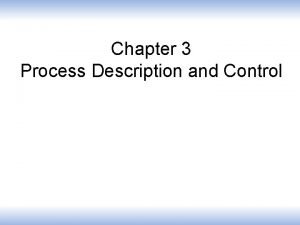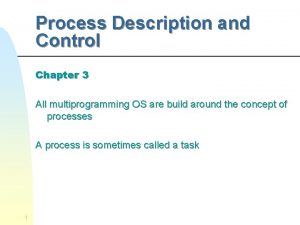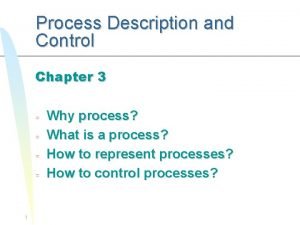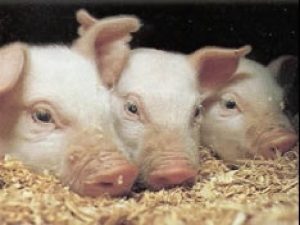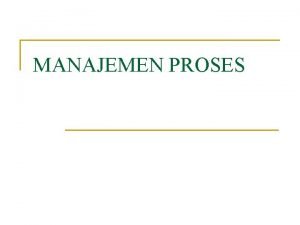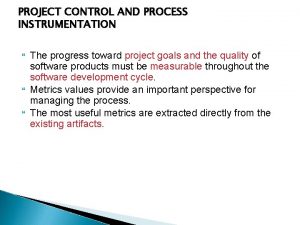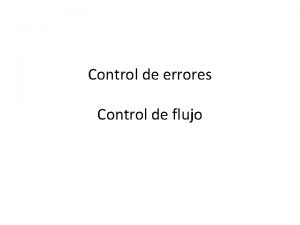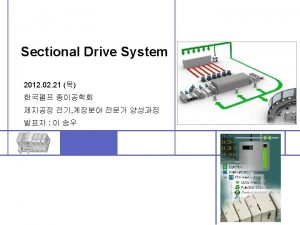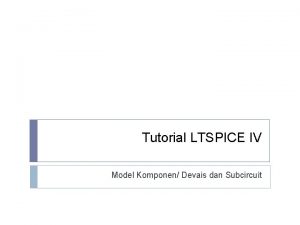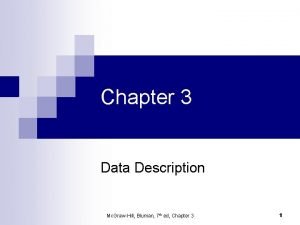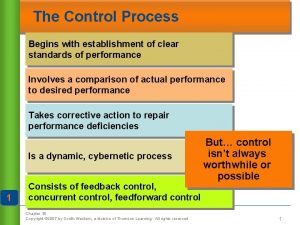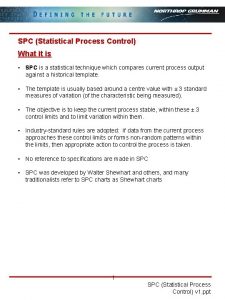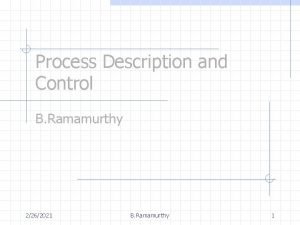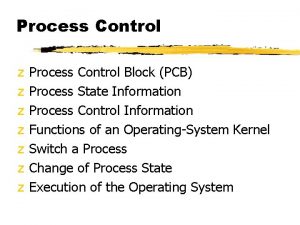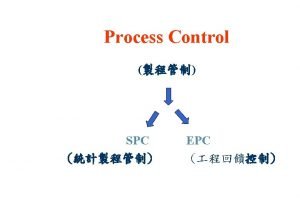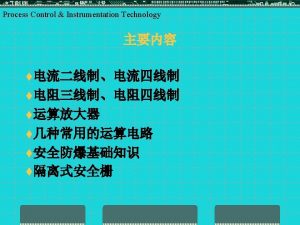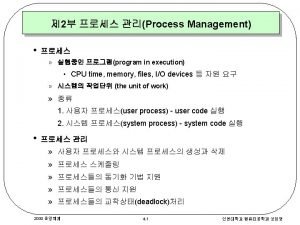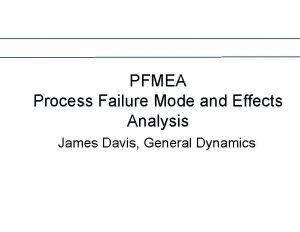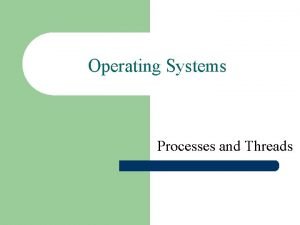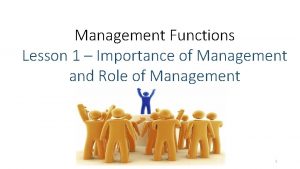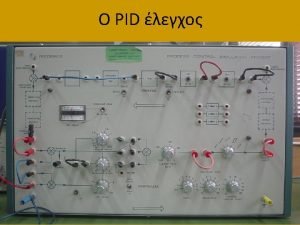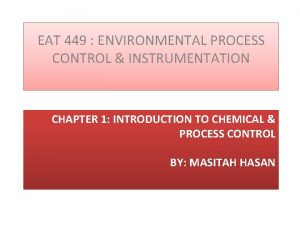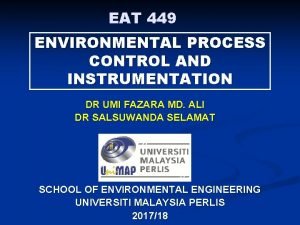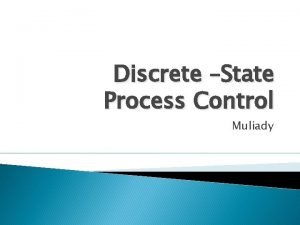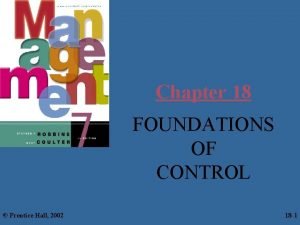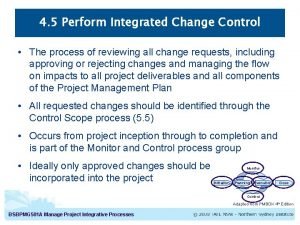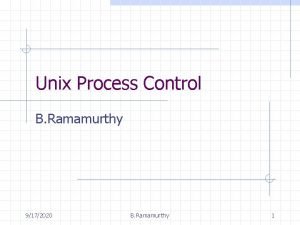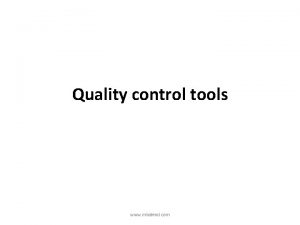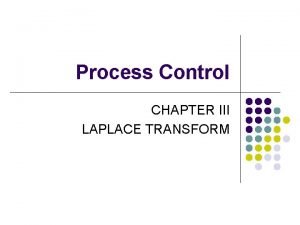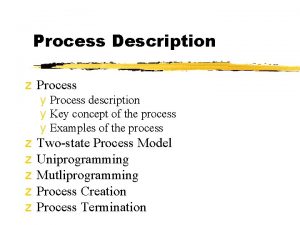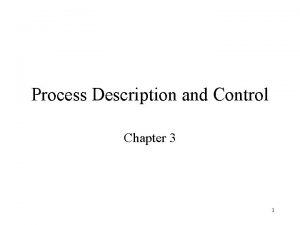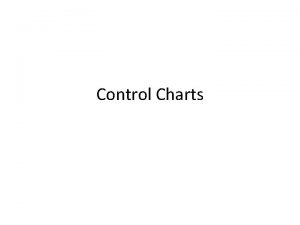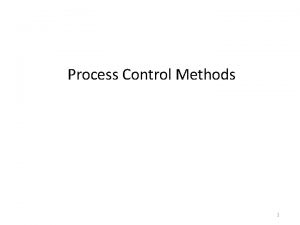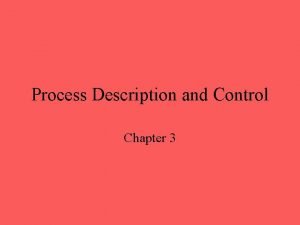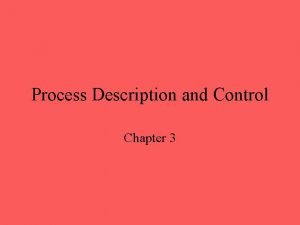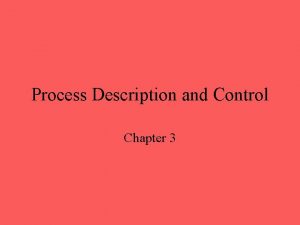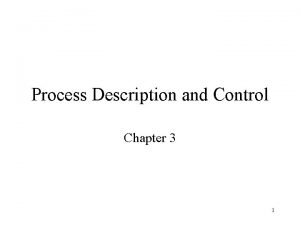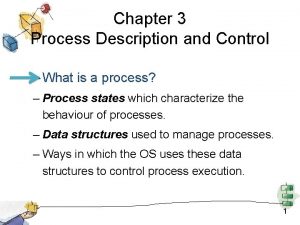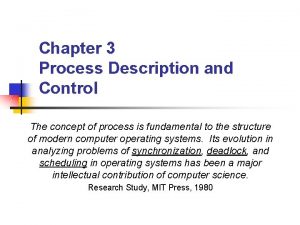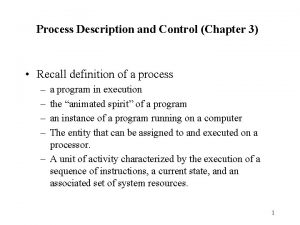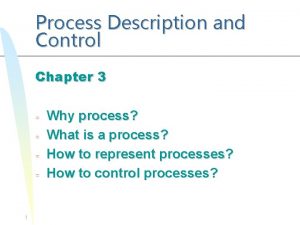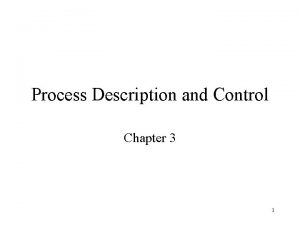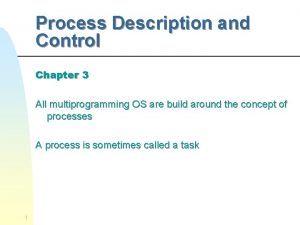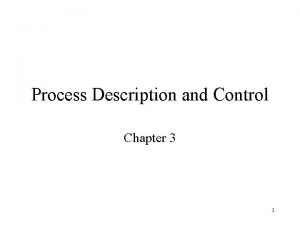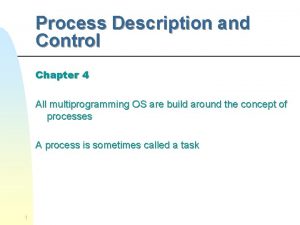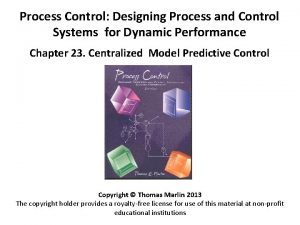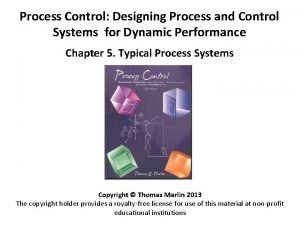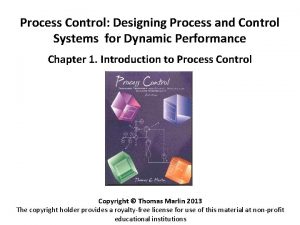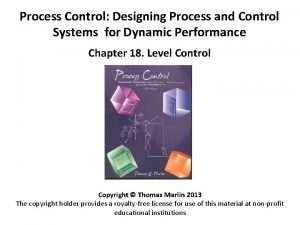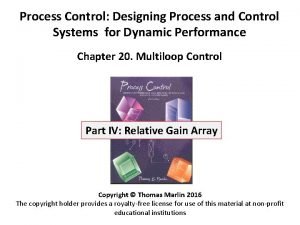Chapter 3 Process Description and Control What is















































- Slides: 47

Chapter 3 Process Description and Control

What is a “process”? • A program in execution • An instance of a program running on a computer • The entity that can be assigned to and executed on a processor • A unit of activity characterized by the execution of a sequence of instructions, a current state, and an associated set of system instructions

Process Elements • A process is comprised of: – Program code – A set of data – A number of attributes describing the state of the process

Process Elements • While the process is running it has a number of elements including – Identifier – State – Priority – Program counter – Memory pointers – Context data – I/O status information – Accounting information

Process Control Block • Contains the process elements • Created and manage by the operating system • Allows support for multiple processes

A Few Linux Commands • • PS TOP HTOP PSTREE WHOAMI KILL W • • • DF FREE SLEEP ECHO PGREP LS

A Few C Function • • • FORK (Create. Process) EXECL EXIT SLEEP PAUSE WAIT (Wait. For. Single. Object) • GETCWD • CHDIR

Trace of the Process • The behavior of an individual process is shown by listing the sequence of instructions that are executed • This list is called a Trace • Dispatcher is a small program which switches the processor from one process to another

Process Execution • Consider three processes being executed. • All are in memory (plus the Dispatcher). • Lets ignore virtual memory for this.

Trace from the processes point of view: • Each process runs to completion

Trace from Processors point of view

Two-State Process Model • Process may be in one of two states – Running – Not-running

Queuing Diagram

Process Birth

Process Creation • The OS builds a data structure to manage the process • Traditionally, the OS created all processes – But it can be useful to let a running process create another – This action is called process spawning – Parent Process is the original, creating, process – Child Process is the new process

Process Termination • There must be some way that a process can indicate completion. • This indication may be: – A HALT instruction generating an interrupt alert to the OS. – A user action (e. g. log off, quitting an application) – A fault or error – Parent process terminating

Five-State Process Model

Process States

Using Two Queues

Multiple Blocked Queues

Suspended Processes • Processor is faster than I/O so all processes could be waiting for I/O – Swap these processes to disk to free up more memory and use processor on more processes • Blocked state becomes suspend state when swapped to disk • Two new states – Blocked/Suspend – Ready/Suspend

One Suspend State

Reason for Process Suspension Reason Comment Swapping The OS needs to release sufficient main memory to bring in a process that is ready to execute. Other OS Reason OS suspects process of causing a problem. Interactive User Request e. g. debugging or in connection with the use of a resource. Timing A process may be executed periodically (e. g. , an accounting or system monitoring process) and may be suspended while waiting for the next time. Parent Process Request A parent process may wish to suspend execution of a descendent to examine or modify the suspended process, or to coordinate the activity of various descendants.

Processes and Resources

Operating System Control Structures • OS manages processes and resources, it must have information about the current status of each process and resource. • Tables are constructed for each entity the operating system manages

OS Control Tables

Memory Tables • Memory tables are used to keep track of both main and secondary memory. • Must include this information: – Allocation of main memory to processes – Allocation of secondary memory to processes – Protection attributes for access to shared memory regions – Information needed to manage virtual memory

I/O Tables • Used by the OS to manage the I/O devices and channels of the computer. • The OS needs to know – Whether the I/O device is available or assigned – The status of I/O operation – The location in main memory being used as the source or destination of the I/O transfer

File Tables • These tables provide information about: – Existence of files – Location on secondary memory – Current Status – other attributes. • Sometimes this information is maintained by a file management system

Process Tables • To manage processes the OS needs to know details of the processes – Current state – Process ID – Location in memory – etc

Process Identification • Each process is assigned a unique numeric identifier. • Many of the other tables controlled by the OS may use process identifiers to crossreference process tables

Structure of Process Images in Virtual Memory

Structure of Process Images in Virtual Memory

Modes of Execution • Most processors support at least two modes of execution • User mode – Less-privileged mode – User programs typically execute in this mode • System mode – More-privileged mode – Kernel of the operating system

Process Creation • Once the OS decides to create a new process it: – Assigns a unique process identifier – Allocates space for the process – Initializes process control block – Sets up appropriate linkages – Creates or expand other data structures

Switching Processes • The steps in a process switch are: – Save context of processor including program counter and other registers – Update the process control block of the process that is currently in the Running state – Move process control block to appropriate queue – ready; blocked; ready/suspend

Switching Processes • Select another process for execution • Update the process control block of the process selected • Update memory-management data structures • Restore context of the selected process

Is the OS a Process? • If the OS is just a collection of programs and if it is executed by the processor just like any other program, is the OS a process? • If so, how is it controlled? – Who (what) controls it?

Execution of the Operating System

Non-process Kernel • Execute kernel outside of any process • The concept of process is considered to apply only to user programs – Operating system code is executed as a separate entity that operates in privileged mode

Execution Within User Processes • Execution Within User Processes – Operating system software within context of a user process – No need for Process Switch to run OS routine

Process-based Operating System • Process-based operating system – Implement the OS as a collection of system process

Unix SVR 4 System V Release 4 • Most of the OS executes in the user process • System Processes - Kernel mode only • User Processes – User mode to execute user programs and utilities – Kernel mode to execute instructions that belong to the kernel.

UNIX Process States

Process Creation • Process creation is by means of the kernel system call, fork( ). • This causes the OS, in Kernel Mode, to: 1. Allocate a slot in the process table for the new process. 2. Assign a unique process ID to the child process. 3. Copy of process image of the parent, with the exception of any shared memory.

Process Creation cont… 4. Increment the counters for any files owned by the parent, to reflect that an additional process now also owns those files. 5. Assign the child process to the Ready to Run state. 6. Returns the ID number of the child to the parent process, and a 0 value to the child process.

After Creation • After creating the process the Kernel can do one of the following, as part of the dispatcher routine: – Stay in the parent process. – Transfer control to the child process – Transfer control to another process.
 What is a process description
What is a process description Process description and control
Process description and control Program vs process
Program vs process Process and product control
Process and product control Control ctrl allergen
Control ctrl allergen Positive and negative controls
Positive and negative controls Control flow errors
Control flow errors Deskripsi proses adalah
Deskripsi proses adalah Describe data and process modeling concepts and tools
Describe data and process modeling concepts and tools The seven core metrics
The seven core metrics Split range
Split range Primary control vs secondary control
Primary control vs secondary control Control volume vs control surface
Control volume vs control surface Stock control e flow control
Stock control e flow control Control volume vs control surface
Control volume vs control surface What is a negative control
What is a negative control Data link control
Data link control Control de flujo y control de errores
Control de flujo y control de errores Negative control vs positive control examples
Negative control vs positive control examples Sectional drive
Sectional drive Komponen ltspice
Komponen ltspice Os coxae
Os coxae Condylar and coronoid process of mandible
Condylar and coronoid process of mandible Summaries to kill a mockingbird
Summaries to kill a mockingbird Chapter 3 data description
Chapter 3 data description Summary of to kill a mockingbird chapter 26
Summary of to kill a mockingbird chapter 26 The control process begins when
The control process begins when Statistical process control ppt
Statistical process control ppt Process control systems
Process control systems Pmi procurement
Pmi procurement Explain the process control block
Explain the process control block Explain the process control block
Explain the process control block Spc ocap
Spc ocap Process control instrumentation technology
Process control instrumentation technology Process control block pcb
Process control block pcb Aiag pfmea
Aiag pfmea What is thread in operating system
What is thread in operating system Example of middle level management
Example of middle level management Velocity lag
Velocity lag Environmental process control
Environmental process control Environmental process control
Environmental process control Discrete state process control
Discrete state process control The control process assumes that
The control process assumes that Perform integrated change control process
Perform integrated change control process Process control
Process control Marketing control process
Marketing control process Mbaknol.com
Mbaknol.com Laplace transform in process control
Laplace transform in process control
